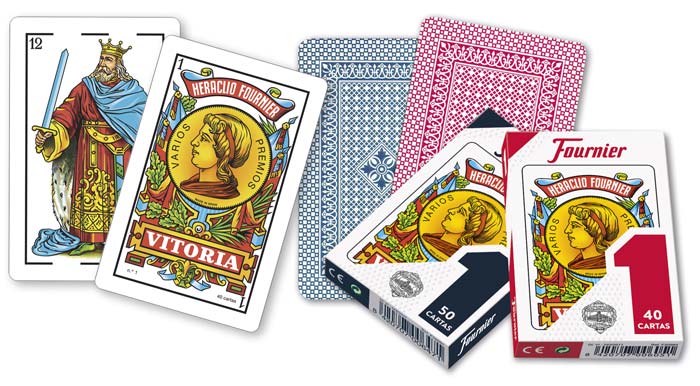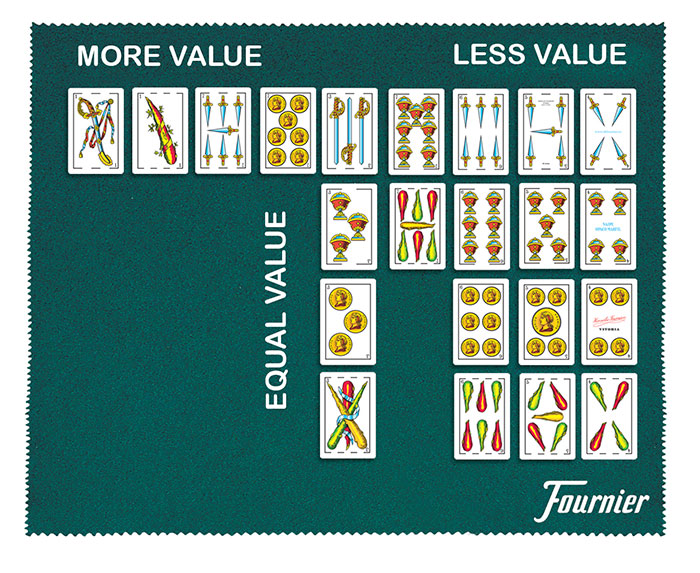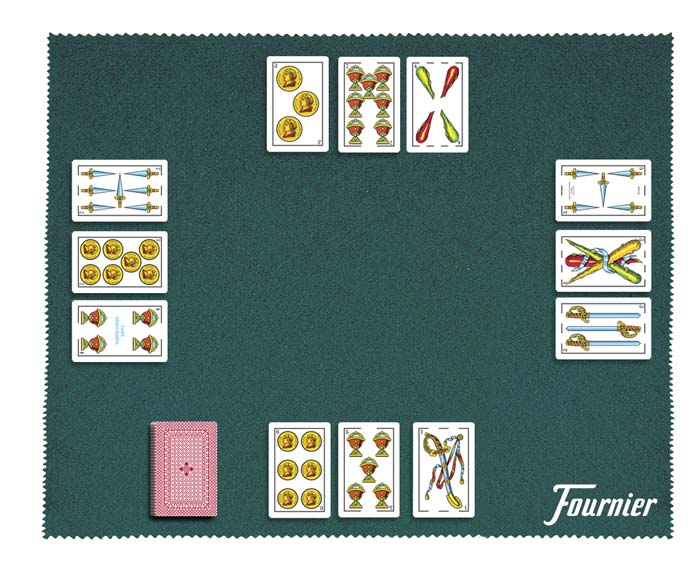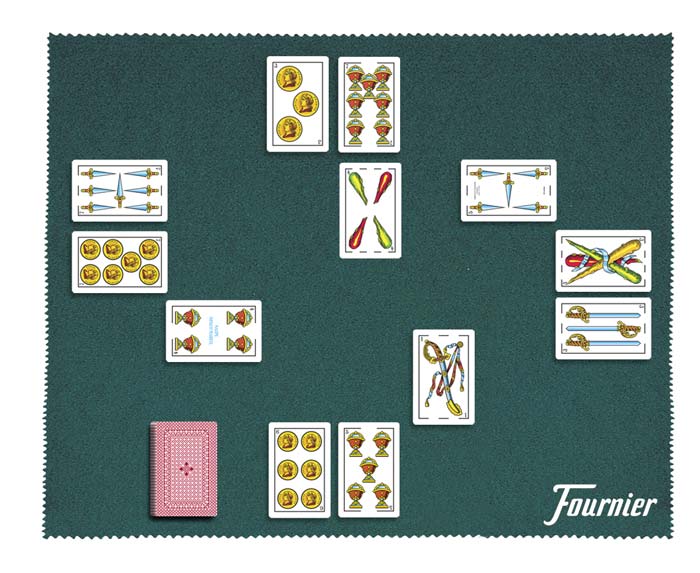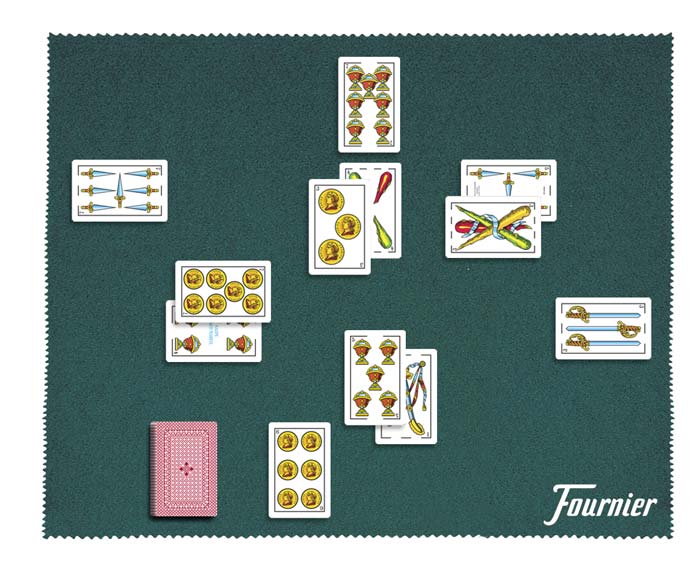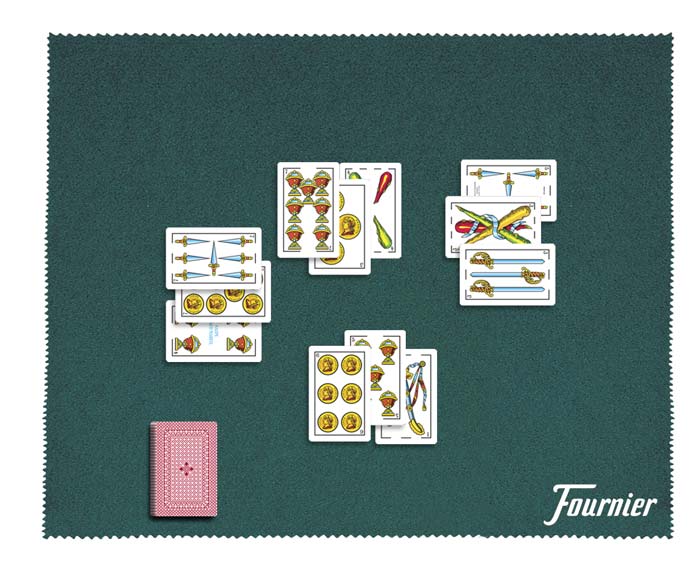Truco is a very popular game in South America. It stems from truc or Valencian Truque. The game consists of two different phases. In the first, players bet on the best card combination of the different hands (Flor and Envido) and in second, on the tricks played with these hands (Truco).
To reach the 30 points, the first 15 bad points and the second 15 good points, necessary to win a Chico. The match is won when a team wins two Chicos. If a draw occurs with the first two Chicos, a third and final Chico is played.
It is played with a 40 card Spanish deck.
Two to eight players can play the game.
These games can be played in two ways: fixed Gallo or Gallo per turn. In the first case, it is always the same player playing against the other two, who pool their points together. In the second case, the three players take it in turns to be the Gallo, who will also be the dealer. In this case, the points obtained by the pair are written down for each one of them in each round.
All players take part in the first partial game, called Redondo or Redondilla. In the following round(s), called Pica/Pica or Pico a Pico, they play independently, with a single deck and a single deal, each player playing against their opponent seated opposite. The team to which a player who interferes in the game of others belongs, loses and has to return the points that they would have collected. The non-offending team will collect 4 points.
When a team reaches 10 good points (25 points), it stops playing Pico a Pico, playing only Redondo. Some prefer to stop playing Pico a Pico as soon as one of the teams starts earn good points, i.e., when it has scored 15 points. When playing Pico a Pico, the Falta Envido is worth 6 points and the maximum that can be bet on the Contraflor is also 6 points, which means that the winner scores 12 points.
The card order is used for the Truco and determines the winner of the trick. Card value is used for the Flor and Envido bets.
There are four special cards in Truco, known as “cartas bravas” (wild cards) and these are the highest in the pack. The rank of these cards, from highest to lowest, are: ace of swords (espadilla), ace of clubs (bastillo), seven of swords and seven of coins (wild sevens).
For the rest, the rank, from highest to lowest, is: threes, deuces, false aces (ace of coins and cups), black cards (kings, knights and jacks) false sevens (seven of cups and clubs), sixes, fives and fours.
The value of the cards, for Flor and Envido, is: black cards score 0 points each and the other cards, their pip values.
Before beginning a game, cards are normally drawn to determine who will be the first to deal. The turn to be dealer is in rotating order, going anticlockwise.
The dealer shuffles the cards and the player to dealer’s left cuts the pack, not leaving three or fewer in the deck or taking three or fewer in the cut. No other player is allowed to cut the deck, nor more than one cut is permitted, they can, however, tap the deck without cutting it. Next, each player is dealt three cards, one at a time, starting with the player on the dealer’s right. If one of the cards falls face up, whoever receives it can choose to keep it or demand a new card.
The player on the dealer’s right is the “hand” and has certain privileges in the game, as well as being the first to play. The last player in each team is the “foot”, who is usually the captain and controls the team’s gameplay. Each player studies their cards and, if they have Flor or good Envido, they inform their partner or team-mates by means of signals, while observing those of all the other players. The “hand” starts the game, announcing Flor, if they have it, betting Envido or playing one of their cards, but regardless of what they do, each player in turn also has these three options until a card is played, at which point the Truco phase of the game starts and it is no longer possible to bid Flor or Envido, although players can still respond to these. Once the bets have been settled, the cards are played to determine the winner of the Truco. After finishing this, the scores for the partial game are noted. A player or team is said to be fishing when they remain silent waiting for their opponents to be the first to bet or Truco in order to respond.
The Flor and the Envido have to be announced during the first trick, and the Truco at any time during the hand. These announcements follow the order Flor, Envido and Truco and each player must respect this order. As Flor has to be announced first, if the first player does not have it and does not want to bet on Envido, they can play a card to initiate the Truco phase or even announce Truco before playing the card. Subsequent players can bet on Flor or Envido but before responding to the Truco bet, otherwise they lose the option to do so. When one of the players bets on Envido, the others have the opportunity to respond to that bet, even if they have played their first card, however, there are no more Envido bets after everyone has played their first card.
The three ways of scoring points in Truco are:
To bid and bet Flor it is necessary to hold three cards of the same suit. This hand is worth the sum of the value of the cards plus 20 points.
This hand is rare and the rules for betting on it are quite complicated. Because it depends mainly on the luck of the deal, most players prefer to play the game without it.
Players have to announce it if they have it in order to avoid a penalty, but are not allowed to announce it if they do not have it. The announcement must be made before playing the first trick or accepting any other type of bids from preceding players, leaving Truco suspended until the hand has been played. Having announced Flor, it is necessary to wait until the next players speak, since all announcements concerning Flor must be resolved before continuing the game. Those who have played the first trick are no longer permitted to do so.
When a player has three cards of the same suit they announce it by saying “flor”. If any other player has Flor, the team of the person with the highest Flor gets the points, plus 3 points for the Flor itself, plus 3 more for each Flor announced. The Flor is worth the sum of the value of the cards plus 20 points.
After announcing Contraflor, the opponents have three possible replies: Con flor quiero, used to accept the bet made; Con flor me achico,
When all the announcements regarding Flor have finished, the bets are settled. Each player, starting with the “hand”, announces the value of their Flor. If the Flor does not beat that announced by a preceding player, they can say “They are good”, admitting that they have lost the bet, unless of course a later player on the same team beats the announced Flor.
The player with the winning Flor has to show their cards before scoring the points.
At the end of the game, any player who suspects that another had Flor but did not announce it, can challenge them by asking or demanding Flor. To do this they say “I request Flor”. If the challenged player had Flor, the challenging team scores 3 points, plus all the points from the opponent’ hand, however, the challenged player shows two cards of a different suit, the challenged team scores 3 or 4 points.
Any player can bet or respond to an Envido bet. Both the bets and responses are made on behalf of the team. A player cannot bet on Envido after they have played their first card or after they have bet or accepted a Truco bet. If a player bets on Truco before an opponent says “envido”, that player can still reply to their Envido bet, only responding to the Truco bet after the Envido betting has finished.
If a player has two cards of the same suit, the hand is worth the sum of these two cards, plus 20 but if the three cards are different suits, the hand is worth the value of the highest card. Meaning that the highest Envido is worth 33 points and the lowest, three different black cards, is worth 0 points.
To bet on Envido it is necessary to say:
If the response to one of these two bets is Envido or Royal Envido, the new response is one the five mentioned, and the value of the bets goes up successively, until one of the two says Okay or Not Okay, which closes the Envido betting. With the bets finished, the players announce the value of their hands. When a player has a worse hand than announced by the other, they need not reveal what they hold and simply say “They are good”. The Envido is won by whoever has the most points. In the case of a draw, priority is given to the first one who bid. The winner of the Envido must show their cards before any points are scored. If winner is mistaken then the opposing team wins, even if they have worse Envido.
Truco is the trick game that is played after Flor and Envido. Each partial game consists of three tricks and to win Truco it is necessary to win two of the tricks. Each player plays one of their cards, the highest card wins the trick. The “hand” leads the first trick and the following tricks are led by whoever wins the previous one, unless there is a draw, in which case the player who led that trick leads again.
When more than one player plays the highest card, if they are on the same team they win but if they are on opposing teams, they draw (parda). The tricks are not gathered in, but remain face up in front of the player who won them. If there is no Truco bet, the team that gets the most tricks wins, scoring 1 point. If there is a draw, the Truco bet is won by the team that wins the next trick. If all three tricks result in a draw, the “hand”’s team wins. If the first and second hands result in a draw, it is not necessary to play the third. The same is true if a team wins the first two tricks, because it has already won Truco. A player can bid Truco at any time, usually during the second trick, increasing its value to 2 points. Any member of the opposing team can respond and their response is made on behalf of the whole team. The responses are Okay to accept the raise or Not Okay to admit defeat and lose 1 point.
Truco is normally played to 30 points. The first 15 points are called bad ones and the next 15, good ones. One player one each team keeps score, totting up the points at the end of each partial game.
Players must take care what they say, not using reserved expressions such as Okay or Not okay, as these might be interpreted as bets. In Envido, bets must be closed with the expressions Okay or Not okay, but if another bet is made, this means that the previous bets have been accepted. In Flor and Truco, the conditions are different. A Flor bet is answered with another or by saying “It is good” if the player has nothing. In Truco, no other bet can be made until the previous one is accepted by saying “Okay”.
In those cases where a double bet is made, if it is accepted or rejected in its totality, a player need only say “Okay” or “Not okay”. If only one part of the bet is accepted, the player must specify which part of the bet is accepted, otherwise both parts will be taken as accepted.
Players can also inform their team-mates what cards they hold by using signals. Such signals can vary from one place to another and players are allowed to invent their own, but here are some of the common ones:
| Ace of swords | Raise your eyebrows |
| Ace of clubs | Wink one eye |
| Seven of swords | Distort mouth to the right |
| Seven of coins | Distort mouth to the right |
| Any three | Bite your bottom lip. |
| Any deuce | Pout your lips, as if kissing. |
| Ace of coins or cups | Open your mouth a little |
| Bad cards | Close your eyes |
| Good cards for Envido | Tilt head forward or to one side. |
If you wish to receive the latest news from Fournier in your email
Sign up!
Are you a distributor, collector, card fan, professional player? At Fournier we have the best exclusive information from within the sector, personalized to suit your interests.
Sign up!